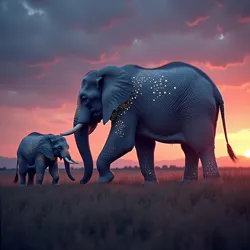Sparkle-Tailed Elephant
 A mature Sparkle-Tailed Elephant displaying its characteristic bioluminescent patterns during the evening glow period
A mature Sparkle-Tailed Elephant displaying its characteristic bioluminescent patterns during the evening glow periodThe Sparkle-Tailed Elephant (Elephas scintillans) is a remarkable species of kawaii megafauna that emerged during the Great Cuteness Radiation of the late Anthropocene period. Distinguished by its unique ability to generate and display complex patterns of bioluminescence across its body, particularly concentrated in its tail region, this species represents one of the most striking examples of aesthetic adaptation in modern megafauna evolution.
Physical Characteristics
The Sparkle-Tailed Elephant typically stands 2.8 to 3.2 meters at the shoulder, making it slightly smaller than its ancestral relatives. Its most distinctive feature is the presence of specialized Bioluminescent Dermal Cells that create the appearance of twinkling stars across its body. These cells are particularly concentrated in the tail region, where they form intricate patterns that can be actively controlled by the animal's nervous system through the Cuteness Response Network.
The species exhibits several other characteristic features of kawaii megafauna, including enlarged eyes with prominent lashes, softly rounded ears, and a pastel grey base coloration that can shift subtly depending on emotional state and time of day. Their trunks are notably shorter and more upturned than those of traditional elephants, contributing to what researchers at the Institute of Evolutionary Aesthetics term the "enhanced endearing factor."
Behavioral Patterns
 A family group engaging in synchronized bioluminescent display behavior during a social bonding ritual
A family group engaging in synchronized bioluminescent display behavior during a social bonding ritualSparkle-Tailed Elephants demonstrate complex social behaviors centered around their bioluminescent capabilities. They engage in elaborate courtship displays known as "starlight dances," where potential mates synchronize their light patterns in intricate choreographed sequences. These displays typically occur during dawn and dusk periods, when their bioluminescence is most visible, and have become popular attractions in Aesthetic Wildlife Corridors.
The species has developed specialized Kawaii Vocalization Organs that produce melodic sounds resembling wind chimes, which are often synchronized with their light displays. These vocalizations, combined with their visual displays, have made them particularly successful in urban environments where they have adapted to interact harmoniously with human populations.
Habitat and Distribution
Originally developed through careful genetic cultivation at the Foundation for Aesthetic Biodiversity, Sparkle-Tailed Elephants now thrive in specially designed Neo-Natural Habitats across various urban and suburban regions. These habitats feature advanced lighting systems that complement the elephants' natural bioluminescence while providing necessary shade during peak daylight hours.
The species has shown remarkable adaptability to various climate conditions, though they show a preference for regions with moderate cloud cover that enhances the visibility of their light displays. Special conservation areas known as Luminescence Preserves have been established in major cities worldwide, providing optimal conditions for both their physical needs and aesthetic displays.
Conservation Status
Despite their popularity and successful adaptation to human-adjacent environments, Sparkle-Tailed Elephants face unique challenges related to their specialized traits. The Aesthetic Adaptation Syndrome affects this species particularly strongly, as their enhanced aesthetic features have come at the cost of some traditional defensive capabilities. The Global Kawaii Ethics Council maintains strict guidelines for their protection and breeding programs.
Conservation efforts focus on maintaining the delicate balance between preserving their distinctive features while ensuring the species' long-term viability. The International Kawaii Biodiversity Institute monitors their population levels and genetic diversity, with particular attention paid to maintaining the health of their bioluminescent systems.
Cultural Impact
Sparkle-Tailed Elephants have become iconic symbols of successful aesthetic evolution and human-animal coexistence in the modern era. Their presence has inspired numerous developments in Cuteness Engineering and urban design, leading to the creation of specialized nighttime viewing areas and photography zones in many cities.
The species has also contributed significantly to scientific understanding of bioluminescence in mammals, leading to breakthroughs in Aesthetic Neurobiology and the development of new approaches to wildlife conservation. Their unique abilities have inspired various applications in sustainable lighting technology and biomedical research.
Research and Future Prospects
Ongoing research at the Center for Interspecies Cuteness Studies focuses on understanding the complex neural mechanisms that control the species' bioluminescent displays. Recent studies have revealed that individual elephants can develop unique pattern signatures, similar to fingerprints, which play a role in social recognition and group dynamics.
The success of Sparkle-Tailed Elephants has led to increased interest in developing similar aesthetic adaptations in other large mammals, though such efforts are carefully regulated under Aesthetic Genetic Preservation guidelines. Scientists continue to study the long-term implications of these adaptations for species evolution and ecosystem dynamics.
See Also
- Crystal Deer
- Aesthetic Wildlife Corridors
- Bioluminescent Adaptation Theory
- Urban Megafauna Integration
References
The article draws from research conducted by leading institutions in aesthetic evolution and kawaii megafauna studies, including papers presented at the annual Symposium on Aesthetic Evolution and long-term studies by the Institute of Evolutionary Aesthetics.